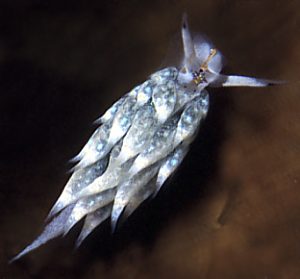
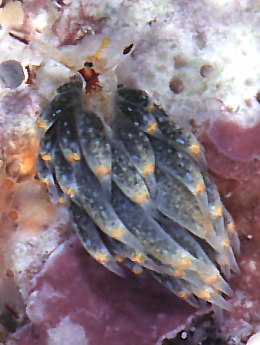
Costasiella kuroshimae
Ichikawa, 1993
Order: SACOGLOSSA
Superfamily: LIMAPONTIOIDEA
Family: Costasiellidae
DISTRIBUTION
Known only from Japanese region.
PHOTO
3.5 mm long, Kerama Is., Okinawa. Photo: Atsushi Ono
Costasiella kuroshimae was described as having a white head with dark marks in the midline and a dark streak across the head just in front of the rhinophores. Also a dark grey-black streak behind the eyes in dorsal midline was described. The tips of the white rhinophores were reported to be black. The cerata were described as 'generally green with white tips'. Iridescent dots are scattered over the green parts of the cerata. Ichikawa described a number of species of Costasiella in a similar brief fashion. Of all the species described, this is the only one that comes near to these photos.
Reference:
• Ichikawa, M. (1993) Saccoglossa (Opisthobranchia) from the Ryukyu Islands. Publications of the Seto Marine Biological Laboratory, 36: 119-139.
Rudman, W.B., 2002 (May 27) Costasiella kuroshimae Ichikawa, 1993. [In] Sea Slug Forum. Australian Museum, Sydney. Available from http://www.seaslugforum.net/find/costkuro
Related messages
Re: Costasiella formicaria from Japan
July 22, 2008
From: Kathe R. Jensen
Concerning message #21723:
Dear Bill,
After reading my message on the Forum I checked the pictures of Costasiella kuroshimae, and I can say that the specimens I collected in Singapore did not have the orange ring or spot on the cerata, but they do have some iridescent blue spots. It is really difficult to distinguish the species just from dorsal pictures. C. kuroshimae does not have pedal tentacles whereas C. paweli does, and C. paweli from Singapore has the orange ring or spot on the cerata.
Best wishes,
Kathe
krjensen@snm.ku.dk
Jensen, K.R., 2008 (Jul 22) Re: Costasiella formicaria from Japan. [Message in] Sea Slug Forum. Australian Museum, Sydney. Available from http://www.seaslugforum.net/find/21734Thanks Kathe,
Badly defined species certainly cause problems. Julie Marshall's photos [message #13448] seem to fit Ishikawa's description and some have a golden ring while others don't. There don't seem to be pedal tentacles in her photos either. I will look forward to your paper when it is published.
Best wishes,
Bill Rudman
Variation in Costasiella ?
January 20, 2006
From: Takao Urasawa
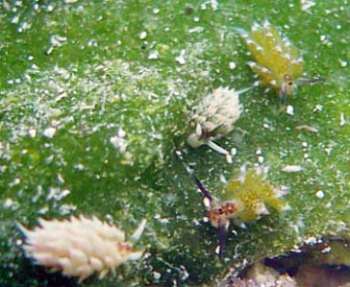
Hafa Adai Dr.Bill,
We wanna show you two kinds of sea slug. Are they the same - the eyes look different. Are they Costasiella kuroshimae, please ?
Locality: Eelgrass Beds, Saipan, Northern Mariana Islands, Pacific Ocean. Depth: 1.5 m. Length: 2 mm. 20 December 2005. on Avrainvillea obscura. Photographer: Takao Urasawa
dswith@isletwind.com
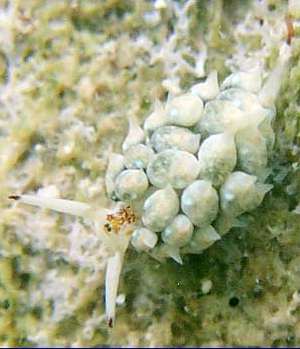
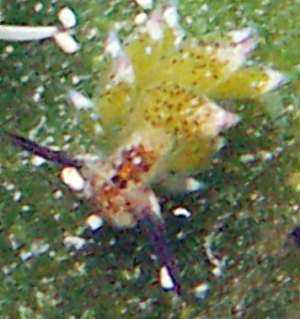
Dear Ura,
I am afraid there are some problems concerned with identifying species of Costasiella. I am afraid many of the species have been described from very few animals so we have little idea how variable they are in colour.
I suspect you have two species here. The paler animal in your lower left photo has only the tip of the rhinophores black, there are traces of blue spots on the cerata, and also traces of a yellowish band on the cerata as well. I suspect this animal is Costasiella kuroshimae. I can't see the characteristic thin yellow, or brownish yellow, median line from the eyes to the front of the head, but it may be the angle of the photo.
The green animal in your lower right photo is the same as the one I am calling Costasiella sp. 3. In that species the top half, or more, of each rhinophore is black, the ceratal wall is transparent, so the green of the digestive gland contents can be seen, and there are traces of the pinkish red patch near the tip of the cerata.
Of the four animal in your upper photo, I think the one near the centre is C. kuroshimae, and the other three are colour phases of Costasiella sp. 3. I may be wrong about the pale one at the bottom left of the photo, but I think it is one which hasn't fed for a while and so hasn't much green colouration.
This is all guesswork on my part, as we know so little about these animals. If you have the opportunity to see them often then why don't you try and see if you can find some way to sort them out? It is possible they have different egg ribbons, perhaps you can see different colour forms mating, etc etc. I suspect it will be people in the field who build up a good knowledge of the populations, who will find a clue to whether we have one, two, or many species. Radular differences are good when they are obviously different, but when differences in radular morphology are very subtle, they are no better than very subtle colour differences. My advice is for you to consider this not as an identification problem but as an opportunity to learn something new about these fascinating animals
Best wishes,
Bill Rudman
Costasiella kuroshimae from Heron Island
April 12, 2005
From: Julie Marshall
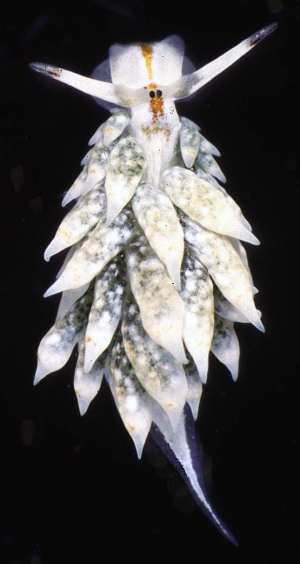
Dear Bill,
Bob Burn was recently at Heron Island [Great Barrier Reef] with me and he spent a lot of time sieving alga on the reef flat at low tide. Several of his finds were specimens of Costasiella kuroshimae which at present you have as only being found from Japan. The animal in the first picture was 3 mm and the other one was 5 mm.
Locality: Heron Island, Great Barrier Reef, Queensland, Australia
Depth: Low tide. Intertidal. Length: 3 mm and 5 mm
13 and 18 March 2005
Photographer: Julie Marshall
Best wishes,
Julie Marshall
juliemarshall@netspace.net.au
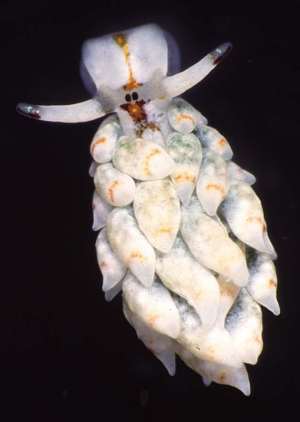
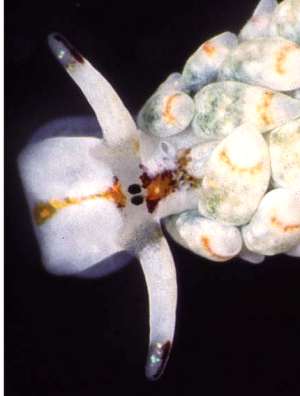
Dear Julie,
Thanks for these excellent photos of such small animals, and thanks to Bob for his diligent seiving! The photos certainly show the characteristic features of this species well. This is to my knowledge the first record of this species outside of Japan and so is a valuable contribution to our knowledge of the group.
Best wishes,
Bill Rudman
Costasiella kuroshimae from Kerama Is.
May 29, 2002
From: Atsushi Ono


Dear Bill,
Here are two images of what I think is Costasiella kuroshimae. There are bright blue spots on the cerata ... and one has orange rings. Their tips of cerata are translucent ... which differ from Ichikawa's original description.
They are 3.5 mm long, on the rope of a fish preserve in Kerama Is. Okinawa.
Sincerely,
Atsushi Ono
ononini@cosmos.ne.jp
Ono, A., 2002 (May 29) Costasiella kuroshimae from Kerama Is.. [Message in] Sea Slug Forum. Australian Museum, Sydney. Available from http://www.seaslugforum.net/find/6226Dear Atsushi,
Thanks for these photos. They are much closer to Ichikawa's description of C. kuroskimae than Erwin Koehler's photos. The differences in your two photos well illustrate the problems of describing species from very few animals. Clearly some animals of this species have a yellow-orange ring on the cerata.
Best wishes,
Bill Rudman
